A Day in the Life of a Training Provider
Course sales. Enrolments. Client emails. Invoices. Reports.
Somewhere in between, you need to develop more courses and grow your training business.
Sound familiar?
Well, what if you had some of that time back? And what if the same time-saving strategies also made it easier to scale your business?
Running a training business often means wearing too many hats: Course creator, marketer, admin, and tech support. For many training providers, admin work becomes a productivity killer that prevents growth. The good news is that automating course sales and delivery can turn things around.
In this post, we’ll show how streamlining your processes with an LMS and eCommerce integration helps you save time, reduce manual work, and scale with ease.
Why Admin Work is Holding Your Business Back
According to Forbes, entrepreneurs spend 36% of their work week on admin tasks like invoicing and data entry. 36%! Training providers in particular often spend more time on operational tasks than growth-driving work like course creation and marketing. Some of these inefficiencies include manually sending invoices or LMS access emails, managing user enrolments one by one, or using multiple plug-ins to handle eCommerce and LMS functions.
These tasks are time-consuming and error-prone, especially when stitched together from different applications. Every hour spent on manual admin is an hour not spent scaling your business. In other words: Delayed course creation, missed sales and an inability to sign more customers. So, how do you get back on track?
Take Back Your Time with eCommerce Automation
A self-serve online store allows your customers to purchase courses on their own, 27/4, with no back-and-forth emails with you or your team required. Automatic course enrolment ensures immediate access after purchase without requiring you to upload a list of learners manually.
An LMS eCommerce integration can also support B2B growth. For example, multi-seat purchases let a single customer buy a course for their whole team. The purchaser can use one of the seats themselves and then invite other team members to the course through email. The interactive LMS tour below lets you explore this scenario using the Firmwater LMS Shopify integration.
You can also offer subscription access to your courses to keep customers engaged over time, without the need for manual renewals or follow-ups. For example, if you want to sell access to an entire course library, you can easily set up a subscription plan with flexible billing options, such as monthly or annual payments. This way, customers enjoy continuous access to your content while you generate recurring revenue effortlessly.
In Shopify’s ranking of the top 10 digital products to sell online, “online courses” is ranked #1. Two of the biggest drivers of this ranking are: (1) the potential for automation and (2) the ability to scale and sell your course to hundreds, or even thousands of learners.

Real-World Impact: Scaling Without the Stress
With automation, even small training providers can take on enterprise clients without expanding their team. The key is shifting your focus from day-to-day admin to higher-value work: building partnerships, developing new courses, and finding new leads. Automation frees up your time so you can prioritize the things that actually move the needle.
In a 2025 Firmwater survey, training providers indicated they use the following marketing strategies: Google Ads, webinars, newsletters and email marketing, among others. Each one of these could be a full time job, but that’s often not realistic for most SMEs who don’t have the budget or staff for full-time marketing. That’s where automation makes a real difference. For instance, AI marketing tools can help personalize and scale marketing without added effort. And eCommerce platforms like Shopify integrate with email marketing platforms like Hubspot and MailChimp so you can automate customer communication based on things like the date an order is placed on your website.
And while marketing gets you noticed, your content is what keeps people coming back. So it’s imperative that course development remains a priority. According to Tom Kuhlmann of eLearning Heroes, it can take about 40-50 hours to develop one hour of e-learning content. But he recommends adding a 30% time buffer to any course creation timeline to account for unexpected hiccups.
Once courses are live, they still require regular attention to ensure your training stays accurate, relevant, and compliant. We recommend updating your content every 1-2 years. Consider things like:
- Browser and device compatibility
- Regulatory changes
- Updated best practices or content accuracy
In the video below, Jen Erb, Managing Director of Tallann Resources, explains how she saved significant admin time and grew revenue with automated course sales.
LMS Support Matters for Success
Good LMS support can be a major time-saver for training providers by minimizing tech headaches and providing professional guidance and support. Here are a few LMS support considerations:
Some LMS leave you on your own: You might be required to set up integrations using WordPress plug-ins or custom APIs. These DIY approaches demand time, technical skill, and ongoing troubleshooting.
When evaluating LMSs for eCommerce, ask how the integration works. Is it a built-in feature? A plug-in? Do you need a third-party service like Zapier, or developer support for an API?
Look for platforms with built-in eCommerce integration: A solution that’s developed in-house by the LMS provider usually means better reliability, tighter integration, and most importantly, direct support when you need it.
Firmwater LMS Connect is a native Shopify app developed by Firmwater. You simply connect it to your LMS site and link courses to products without having to manage APIs or custom code.
A strong support team that understands the integration inside and out can save you hours of setup time and help you avoid frustrating issues down the line. It’s the difference between managing a cobbled-together system and having one that works with support from the people who built it.
Take Back Your Time
Admin overload can be a bottleneck for training providers. But it doesn’t have to be this way. Automating course sales, user enrolment, and subscription management with the right tools can free up hours each week. The result is more time to grow your business, support your clients, and build content that sells.
Ready to ditch admin work and scale smarter? Book a demo today.




